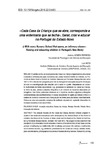Mostrar o rexistro simple do ítem
«Cada Casa da Criança que se abre, corresponde a uma enfermaria que se fecha». Gerar, criar e educar no Portugal do Estado Novo
| dc.contributor.author | Ferreira, António | |
| dc.contributor.author | Mota, Luís | |
| dc.date.accessioned | 2019-07-12T08:22:23Z | |
| dc.date.available | 2019-07-12T08:22:23Z | |
| dc.date.issued | 2018 | |
| dc.identifier.citation | Gomes Ferreira, A., & Mota, L. (2019). «With every Nursery School that opens, an infirmary closes». Raising and educating children in Portugal’s New State. Sarmiento. Revista Galego-Portuguesa De Historia Da Educación, 22, 133-152. https://doi.org/10.17979/srgphe.2018.22.0.5483 | es_ES |
| dc.identifier.issn | 1138-5863 | |
| dc.identifier.uri | http://hdl.handle.net/2183/23515 | |
| dc.description.abstract | [Resumo] A análise centra-se no programa das Casas da Criança enquadrado na obra social e educativa edificada pela ação, sucessiva, das Juntas Geral do Distrito de Coimbra, da Província da Beira Litoral e Distrital de Coimbra, lideradas por Fernando Bissaya Barreto, entre 1927 e 1974. Discute-se o programa pelo viés da inovação em educação enquanto introdução do novo e a reconfiguração das relações com o saber e o poder. Interpelamos um conjunto multivariado de fontes arquivísticas, e.g., processos de admissão às Casas da Criança, os livros de atas, plantas e alçados, fotografias e um conjunto de trabalhos elaborados por estagiárias. Das fontes publicadas destacam-se a imprensa escrita e algumas publicações contemporâneas dos acontecimentos. O corpus documental foi sujeito ao método crítico e à análise de conteúdo e recorreu-se à triangulação de fontes para uma leitura mais totalizante. Obteve-se uma compreensão complexa da realidade educacional, captando dimensões de inovação educativa e dos seus limites | es_ES |
| dc.description.abstract | [Abstract] The analysis focuses on the Casas da Criança (Nursery School) program included in the social and educational work developed by the General Board of the District of Coimbra, the Board of the Province of Beira Litoral and the Board of the District of Coimbra, led by Fernando Bissaya Barreto, between 1927 and 1974. The program is discussed from the standpoint of pro-innovation bias in education in terms of the introduction of new ideas and the process of reshaping our relationship with knowledge and power. We address a multivariate set of archival sources, e.g. admission procedures to the Casas da Criança, minutes books, plans and elevations, photographs and a series of studies done by trainees. Noteworthy among the published sources are the printed media and some of the contemporary publications of the events. The documentary works were examined using the critical method and a content analysis. The triangulation of data sources was also used to obtain a more comprehensive reading. A complex understanding of the educational situation was obtained, with insight into the dimensions of educational innovation and its limits. | es_ES |
| dc.language.iso | por | es_ES |
| dc.publisher | Universidade da Coruña | es_ES |
| dc.relation.uri | https://doi.org/10.17979/srgphe.2018.22.0.5483 | es_ES |
| dc.rights | Atribución-CompartirIgual 4.0 España | es_ES |
| dc.rights.uri | http://creativecommons.org/licenses/by-sa/3.0/es/ | * |
| dc.subject | Inovação educativa | es_ES |
| dc.subject | Casas da criança | es_ES |
| dc.subject | Bissaya Barreto | es_ES |
| dc.subject | Estado novo | es_ES |
| dc.subject | Educação de infância | es_ES |
| dc.subject | Educational innovation | es_ES |
| dc.subject | Early childhood education | es_ES |
| dc.title | «Cada Casa da Criança que se abre, corresponde a uma enfermaria que se fecha». Gerar, criar e educar no Portugal do Estado Novo | es_ES |
| dc.title.alternative | «With every Nursery School that opens, an infirmary closes». Raising and educating children in Portugal’s New State | es_ES |
| dc.type | info:eu-repo/semantics/article | es_ES |
| dc.rights.access | info:eu-repo/semantics/openAccess | es_ES |
| UDC.journalTitle | Sarmiento: Anuario galego de historia da educación | es_ES |
| UDC.volume | 22 | es_ES |
| UDC.startPage | 133 | es_ES |
| UDC.endPage | 152 | es_ES |






